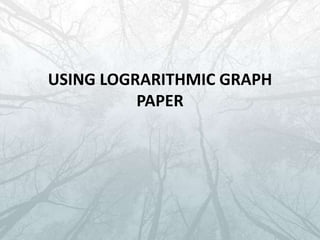
Using lograrithmic graph paper
- 2. Introduction • Logarithmic graph paper is seldom seen by students in elementary courses. There seems to be a general impression that (1) it is too difficult to deal with, or (2) students "can pick it up" without instructions. Niether is true, in my opinion. • In the days of slide rules, students had (or ought to have had) intimate familiarity with logrithms and logarithmic scales, for every slide rule had at least two such scales. Nowadays many of these gory details are hidden in the innards of an electronic calculator or computer, a "black box" that grinds out numbers, whether or not those numbers have any significance. • Graphs with logarithmic scales are found in research papers and textbooks. One example is the usual graph of the electromagnetic spectrum. If students are to interpret such graphs intelligently, they need to directly experience the process of making one. • All sorts of computer graphing software is available. The most used software is designed for the needs of business, not science. Many such software packages simply cannot do the things necessary for dealing with the needs of physics.
- 3. LOGARITHMIC GRAPH PAPER Logarithmic graph papers are available in many types. They simplify the process of linearizing exponential and power relations and determining the constants in their equation.
- 4. Logarithmic scales • Starting from the left, we see labels from 1 to 10, repeated three times. Each segment labeled from 1 to 10 is called a cycle. This sample has 3 cycles. The labeling already printed on the paper is for convenience only; the user must relabel the axes to suit the data. • For example, suppose you want to plot data values ranging from 2 units to 800 units on this three cycle log scale. The first cycle is labeled "as is" from 1 to 9. The second cycle is relabeled 10, 20, 30, 40, 50, 60, 70, 80, and 90. The third cycle is relabeled 100, 200, etc. to 1000. • Each cycle covers a range of values spanning one factor of 10. The next cycle covers a range 10 times larger, etc. The value zero does not appear on a logarithmic scale, for log (0) = minus infinity. • The "generic" labeling is done differently on different brands of paper. Some label the start of a cycle with "1"; some use "10". Some mark 1.5 and 2.5; some don't. • The user has less freedom in labeling a log scale than a linear one. The scales are directed, i.e., one-way, and cannot be labeled in the opposite direction. • The underlying principle of the log scale is that lengths along the scale are proportional to the logarithms of the plotted values. The C and D scales of slide rules are constructed the same way. • The user must carefully examine the markings of the scale to correctly interpret its subdivisions. Some intervals have 10 subdivisions, some only five (every second one of the ten being shown). Errors in the use of log paper result from failure to notice these differences in the way subdivisions are labeled. • Graph papers with one linear and one logarithmic scale are called semi-logarithmic, log-linear, or simply logarithmic. Graph papers with both scales logarithmic are called log-log, full log, or dual logarithmic. • As is evident from the 10 divisions of each cycle, these logarithmic scales represent base-10 logarithms.
- 5. RESCALING LOGARITHMIC SCALE We have so far only considered rescaling log scales by multiplying each scale value by some factor of 10. This preserves the cycle length. Other labelings are possible, but one must exercise great care to avoid blunders in plotting. (1) The scale values may be multiplied by any common factor. A factor of 2 or 4 is easiest to deal with. This operation preserves cycle length, but shifts the cycles along the axis. This can be useful when the data spans only one factor of 10, but would fall in two adjacent decades. See Fig. 7.11. (2) The scale values may be raised to any common power. This expands or contracts the cycle size. This can be useful when you need two cycle paper but have only one cycle paper. Raise all of the values printed along the scale to the second power. See Fig. 7.12. This should be considered strictly an emergency expedient, never acceptable in a graph intended for publication. Another emergency trick is to splice the paper. Suppose you had data that spanned only one factor of 10 but spanned two cycles of the paper. For example, the values might range from 45 to 312. If you used two cycle paper, this graph would occupy less than half of the paper. If you cut one cycle paper at the "4" mark, it could be spliced together so that it reads from 40 to 400.
- 6. SEMI-LOGARITHMIC GRAPH PAPER Semilog graph paper is set up very differently from traditional graph paper. While, on traditional graph paper, the y-axis interval markings are at regular distances from one another (for instance, 1 to 10, 10 to 20, 20 to 30), on semilog graph paper, the y-axis is broken up into cycles, ranging from 0.1 to 1, 1 to 10, 10 to 100, and so forth. Within each cycle, the base line is the beginning of the cycle, and each line above the base line is the multiple of the line below it. For instance, in the 0.1 to 10 cycle, 0.1 would be the baseline, the next line would be two times the baseline (0.2), the line after would be three times the baseline (0.3), and so forth. Fortunately, making graphs on semilog graphing paper is quite similar to making graphs on regular graphing paper.
- 7. If you need logarithmic or any other paper, take a look at these paper templates: http://www.intmath.com/downloads/graph- paper.php or here http://www.papersnake.com/logarithmic/